Peloponnesian War › Indo-European Languages » Ancient origins
Articles and Definitions › Contents
- Peloponnesian War › Ancient History
- Indo-European Languages › Antique Origins
Ancient civilizations › Historical and archaeological sites
Peloponnesian War › Ancient History
Definition and Origins
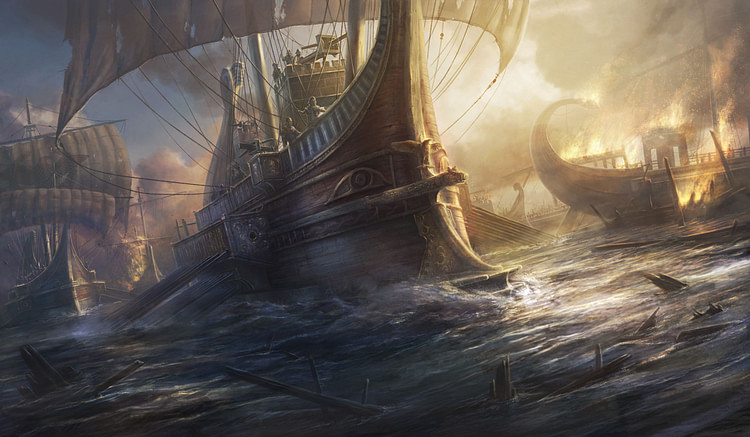
The Peloponnesian War fought between ancient Athens and Sparta (who won) and their respective allies came in two stages, the first from c. 460 to 446 BCE and the second and more significant war from 431 to 404 BCE. With battles occurring at home and abroad, the long and complex conflict was damaging to both sides but Sparta, with financial help from Persia, finally won the conflict by destroying the Athenian fleet at Aegospotami in 405 BCE.
CAUSES OF THE WAR
In the 5th century BCE Sparta and Athens were the two major powers in Greece and it was perhaps inevitable that their spheres of influence would overlap and cause conflict. Sparta seems to have been particularly alarmed at the growing power of Athens, able to build an ever-bigger fleet of ships thanks to tributes from its allies and dependants. Sparta was also suspicious of the Athenians' project to rebuild their Long Wall fortifications which protected their harbour of Piraeus. In addition, Sparta was also concerned that inaction would push the other major Greek power, Corinth, to side with Athens.
What has become known as The First Peloponnesian War (c. 460-446 BCE) was less intense than the second and fought mainly between Athens and Corinth with occasional intervention by Sparta. The war was followed by the Thirty Year's Peace although in reality hostilities never fully ceased and broke out into full war once again from 431 BCE.
GREEK CIVILIANS BECAME MUCH MORE INVOLVED IN WARFARE & THE ENTIRE CITIZEN BODIES OF CITY -STATES COULD BE WIPED OUT.
A flashpoint in Spartan-Athenian relations was Poteidaia in 432 BCE. Athens wanted timber and minerals from Thrace and so demanded Poteidaia remove their fortifications. The Poteidaian's asked for Sparta's protection and received a promise of assistance. Athens went ahead and laid siege to the city anyway, shortly after, also issuing the Megarian Decrees. These prevented Megara from using any port of Athens or her allies, effectively imposing a trade embargo. Sparta, a long-time ally of Megara, asked Athens to repeal the decree as it would make Megara wholly dependent on Athens. The Athenians, cajoled by Pericles, refused but the Spartans withheld from formally declaring war, perhaps due to their state of unreadiness for another long conflict. In fact, though, hostilities broke out elsewhere when Thebes attacked Plataea, an ally of Athens, and in 431 BCE the Peloponnesian army led by the Spartan king Archidamos invaded and ravaged Attica. The War was back on again.
Warfare in the Second Peloponnesian War became more sophisticated and more deadly with the conventions of warfare breaking down and resulting in atrocities previously unthinkable in Greek warfare. Civilians became much more involved in warfare and entire citizen bodies could be wiped out as happened at Mykalessos in Boeotia. The number of casualties in the wars was, therefore, far greater than in any previous conflict in Greece's long history.
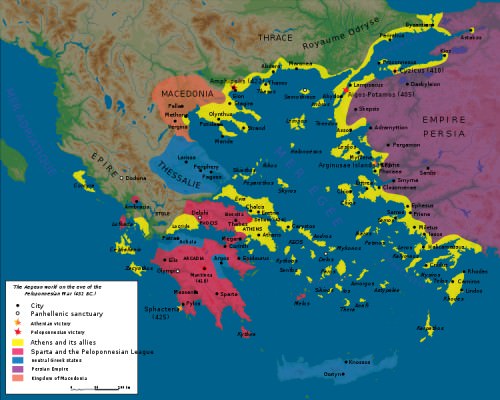
Peloponnesian War
ATHENS & HER ALLIES
Following the Persian Wars of the early 5th century BCE the Greek city-states or poleis began to align themselves in protective alliances. Many states sided with Athens, notably those from Ionia, and together they formed the Delian Leaguesometime around 478 BCE. The League, at its greatest size was composed of over 300 members who paid tribute to Athens, the strongest naval power in Greece, in the form of either ships or money in return for Athenian protection against a perceived threat from Persian and perhaps also Mediterranean pirates. The treasury of the League was placed on the sacred island of Delos in the Cyclades.
THE PRACTICAL CONSEQUENCE OF THE DELIAN LEAGUE WAS THAT ATHENS' NAVY COULD NOW STRIKE ANYWHERE.
Starting with the repression of Naxos, however, the League swiftly came to resemble an Athenian empire rather than a collection of equal allies, a process confirmed by the moving of the treasury to Athens in 454 BCE. Whatever the politics, the practical consequences of the League was that Athens' navy could strike anywhere, especially after rival sea-power Aeginawas taken, and it caused significant supply problems to several cities throughout the war, notably Corinth.
SPARTA & HER ALLIES
The tough military training in Sparta, which started from the age of seven and was known as the agōgē, resulted in a professional hoplite army capable of great discipline and relatively sophisticated battle manoeuvres which made them feared throughout Greece, a fact perhaps evidenced by Sparta's notable lack of fortifications for most of its history.
The regional instability in Greece in the late 6th century BCE brought about the Peloponnesian League (c. 505 to 365 BCE) which was a grouping of Corinth, Elis, Tegea and other states (but never Argos ) where each member swore to have the same enemies and allies as Sparta. Membership of the League did not necessitate the paying of tribute to Sparta but rather the provision of troops under Spartan command. The League would allow Sparta to establish hegemony over and dominate the Peloponnese until the 4th century BCE.

Greek Hoplites
INNOVATIONS IN WARFARE
Like all great conflicts, the Peloponnesian War brought about changes and developments in warfare. The heavily armed hoplite in the phalanx formation (lines of closely packed hoplites protecting each other with their shields) still dominated the Greek battlefield but the phalanx did become deeper (more rows of men) and wider (a longer front of men) during the Peloponnesian War. The dominance of the hoplite on the battlefield was also threatened by the deployment of combined arms using mixed troops - hoplites, light infantry and cavalry - a tactic which became ever more widespread.
Other developments in warfare included an increase in the use of slaves, mercenaries and foreigners in Greek armies, better logistics which allowed armies to stay longer in the field, and a greater attention paid to skills and experience when selecting military leaders. Weapons generally did not develop in respect to earlier conflicts although there were exceptions such as the primitive flame throwers which were used against the wooden fortifications of Delon in 424 BCE.
SPARTA'S INVASIONS OF ATTICA
With one side predominantly a land-based army and the other a great maritime power it is not perhaps surprising that the war dragged on for decades with indecisive victories and ineffectual raids. The principal Spartan strategy was to annually attack Athenian lands, starting in 431 BCE, creating as much destruction as possible such as burning farms, chopping down olive trees and vineyards. However, the actual effect of this on the Athenian economy is unclear, especially when considering that the city could always be resupplied by sea via the city's port of Piraeus protected by the Long Walls. It may have been a Spartan strategy to entice the Athenians out from behind their fortifications into open battle, a temptation that Athens, and particularly Pericles, always resisted. Athens could also and did retaliate by landing troops by sea into Spartan territory and inflict similar damage.
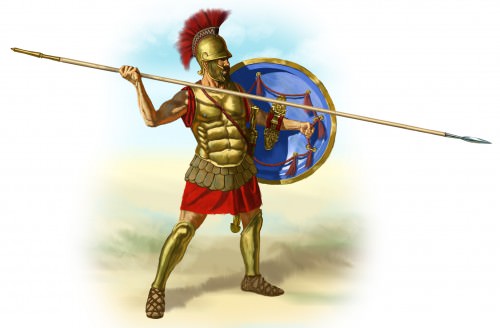
Greek Hoplite
Athens was hit by a devastating plague (arriving from Egypt via Persia) in 430 BCE and Sparta even postponed her annual invasion to avoid it. In the same year Pericles was ousted and Athens sued for peace only to be rejected by Sparta. However, under Kleon and Nikias, the Athenians enjoyed a successful campaign in the Corinthian Gulf in 429 BCE and hopes for an early Spartan victory now seemed hopelessly ambitious.
IF A CITY DID FINALLY FALL AFTER A SIEGE THEN DEATH OR SLAVERY WAS THE USUAL RESULT FOR THE DEFEATED.
SIEGES
Sieges were another common feature of the Peloponnesian War. They were already a feature of Greek warfare but they increased dramatically in number during the Peloponnesian Wars, reaching around 100, 58 of which were successful (for the attackers). Siegecraft involved two main strategies - repeatedly attacking the city directly (until the defenders capitulated or the walls were breached) and circumvallation or surrounding the city with a wall (and starving the city into surrender). In the latter strategy there was also the hope that betrayal and in-fighting might also compromise the defenders. The second strategy was much more costly and time-consuming as it often took years to achieve success. If a city did finally fall then death or slavery was the usual result for the defeated.
The next action in the war was the siege of Plataea between c. 429-427 BCE which had elements of both siege strategies.First, the Peloponnesian forces used more aggressive tactics by blockading the town with a wooden palisade and building an earth ramp to compromise the walls. However, the Plataeans responded to this threat by building even higher walls. The Peloponnesians then used battering rams ( embole ) against the walls but the defenders once again thwarted the attackers by dropping large beams on chains to break the rams. The attackers then decided to dig in for a long siege and play the waiting game, a strategy that was ultimately successful as they starved the Plataeans into surrendering but only after two years.

Piraeus & The Long Walls
THE WAR RUMBLES ON
In 428 BCE Athens ruthlessly crushed a revolt on Lesbos involving Mytilene and in 427 the fall of Plataea was followed by a civil war on Kerkyra ( Corfu ) and a failed Athenian attempt to support Leontinoi in Sicily. In 426 BCE Demosthenes led 40 triremes in a campaign against Pylos (they were in fact on their way to Sicily) where they defeated the Spartans occupying Sphakteria. In 424 BCE the Athenians launched an expedition against Megara and Boeotia but this was another failure and involved a heavy defeat near Delion. Athens did, however, take the Spartan island of Kythera. The Spartans too had successes, now commanded by Brasidas and using non-Spartan hoplites for the first time, they captured several poleis in Attica, notably Amphipolis - although both Kleon and Brasidas were killed in the battle.
In 423/421 BCE a truce was called and a 50 year peace was agreed. There were some territorial concessions on both sides but principally the situation returned to the pre-war status quo. However, individual commanders in the field refused to hand over cities and an alliance was formed between Mantineia, Argos, Elis, Corinth and the Chalkidians. In 420 BCE Sparta formed an alliance with Boeotia. Also in 420 BCE the new Athenian leader Alcibiades brokered an alliance between Athens, Argos, Elis and Mantineia. It looked very much like both sides were manoeuvring for a re-start.
In 418 BCE there was the major battle at Mantineia where Sparta, led by Agis II, defeated Argos and her allies. The war now took on a more brutal aspect with Sparta killing all the citizens of Hysiai (417/16 BCE) and Athens, in the same period, executing the citizens of Melos.

Alcibiades
THE SICILIAN EXPEDITION
In 415 BCE Athenian general Alcibiades was the mastermind behind the invasion of Sicily, the largest operation of the entire war. Athens wanted Sicilian timber for her fleet and the pretext for the attack was a request for help from the small polis of Segesta which sought protection from Syracuse. However, on the eve of departure Alcibiades was implicated in serious accusations of impiety and was stripped of command. Not wishing to face what he felt would be a biased trial, Alcibiades fled to Sparta. The military operation continued under Nikias but was a complete disaster, an ineffectual siege was broken by a Spartan army led by Glypus, the Athenian fleet was routed in the harbour of Syracuse and both Nikias and Demosthenes were executed in 413 BCE.
THE WAR WAS FINALLY WON BY SPARTA, THEN, & PERHAPS IRONICALLY, IN A NAVAL BATTLE.
AEGOSPOTAMI & VICTORY
Athens was not beaten yet though and she continued to raid the Peloponnese from the sea. Sparta, following the advice of Alcibiades, built a fort at Dekeleia to more easily disrupt Attic agriculture with their annual attacks on Attic farmland. Agis made his headquarters at Dekeleia and received envoys from various poleis wishing to leave the Delian League, notably Chios and Miletos. Persia also made overtures to Sparta, offering money with which to build a fleet that could challenge Athens in return for Sparta recognising Persian sovereignty in Asia Minor.
The War was finally won by Sparta, then, and perhaps ironically, in a naval battle. After a long series of naval defeats to the Athenians and even an unsuccessful sue for peace after the naval defeat to Alcibiades at Kyzikos in 410 BCE, Sparta was able to build a massive fleet of 200 triremes using Persian money and timber. With this formidable weapon, Lysander was able to inflict a final and total defeat on the Athenians at Aegospotami near the Hellespont in 405 BCE where 170 Athenian ships were captured on the beach and at least 3,000 Athenian captives were executed. Now unable to man another fleet, with the Delian League disbanded and Athens itself under siege, the Athenians had no option but to sue for peace. Conditions of surrender were the dismantling of the Long Walls, the prohibition of rebuilding a fleet bigger than 12 ships and the payment of tribute to Sparta, which was now, finally, recognised by all as the dominant power in Greece.
AFTERMATH
Sparta's position as the number one city-state in Greece, though, was to be short-lived. Continued Spartan ambitions in central and northern Greece, Asia Minor and Sicily once again dragged the city into another protracted conflict, the Corinthian Wars with Athens, Thebes, Corinth and Persia from 396 to 387 BCE. The result of the conflict was the 'King's Peace' where Sparta ceded her empire to Persian control but Sparta was left to dominate Greece. However, trying to crush Thebes, Sparta lost the crucial battle of Leuctra in 371 BCE against the brilliant Theban general Epaminondas. Perhaps the real winner of the Peloponnesian Wars was actually, then, Persia and in the long term even Macedonia which under Philip II was able to invade and crush with relative ease the weakened and mutually suspicious Greek city-states.
Indo-European Languages › Antique Origins
Definition and Origins

The Indo-European languages are a family of related languages that today are widely spoken in the Americas, Europe, and also Western and Southern Asia. Just as languages such as Spanish, French, Portuguese and Italian are all descended from Latin, Indo-European languages are believed to derive from a hypothetical language known as Proto-Indo-European, which is no longer spoken.
It is highly probable that the earliest speakers of this language originally lived around Ukraine and neighbouring regions in the Caucasus and Southern Russia, then spread to most of the rest of Europe and later down into India. The earliest possible end of Proto-Indo-European linguistic unity is believed to be around 3400 BCE.
Since the speakers of the Proto-Indo-European language did not develop a writing system, we have no physical evidence of it. The science of linguistics has been trying to reconstruct the Proto-Indo-European language using several methods and, although an accurate reconstruction of it seems impossible, we have today a general picture of what Proto-Indo-European speakers had in common, both linguistically and culturally. In addition to the use of comparative methods, there are studies based on the comparison of myths, laws, and social institutions.
THE ANCIENTS CAME UP WITH THE EXPLANATION THAT THE LATIN LANGUAGE WAS A DESCENDANT OF THE GREEK LANGUAGE.
BRANCHES OF INDO-EUROPEAN LANGUAGES
The Indo-European languages have a large number of branches: Anatolian, Indo-Iranian, Greek, Italic, Celtic, Germanic, Armenian, Tocharian, Balto-Slavic and Albanian.
Anatolian
This branch of languages was predominant in the Asian portion of Turkey and some areas in northern Syria. The most famous of these languages is Hittite. In 1906 CE, a large amount of Hittite finds were made on the site of Hattusas, the capital of the Hittite Kingdom, where about 10,000 cuneiform tablets and various other fragments were found in the remains of a royal archive. These texts date back to the mid to late second millennium BCE. Luvian, Palaic, Lycian, and Lydian are other examples of families belonging to this group.
All languages of this branch are currently extinct. This branch has the oldest surviving evidence of an Indo-European language, dated about 1800 BCE.
Indo-Iranian
This branch includes two sub-branches: Indic and Iranian. Today these languages are predominant in India, Pakistan, Iran, and its vicinity and also in areas from the Black Sea to western China.
Sanskrit, which belongs to the Indic sub-branch, is the best known among the early languages of this branch; its oldest variety, Vedic Sanskrit, is preserved in the Vedas, a collection of hymns and other religious texts of ancient India. Indic speakers entered into the Indian subcontinent, coming from central Asia around 1500 BCE: In the Rig- Veda, the hymn 1.131 speaks about a legendary journey that may be considered a distant memory of this migration.
Avestan is a language that forms part of the Iranian group. Old Avestan (sometimes called Gathic Avestan) is the oldest preserved language of the Iranian sub-branch, the “sister” of Sanskrit, which is the language used in the early Zoroastrian religious texts. Another important language of the Iranian sub-branch is Old Persian, which is the language found in the royal inscriptions of the Achaemenid dynasty, starting in the late 6th century BCE. The earliest datable evidence of this branch dates back to about 1300 BCE.
Today, many Indic languages are spoken in India and Pakistan, such as Hindi-Urdu, Punjabi, and Bengali. Iranian languages such as Farsi (modern Persian), Pashto, and Kurdish are spoken in Iraq, Iran, Afghanistan, and Tajikistan.
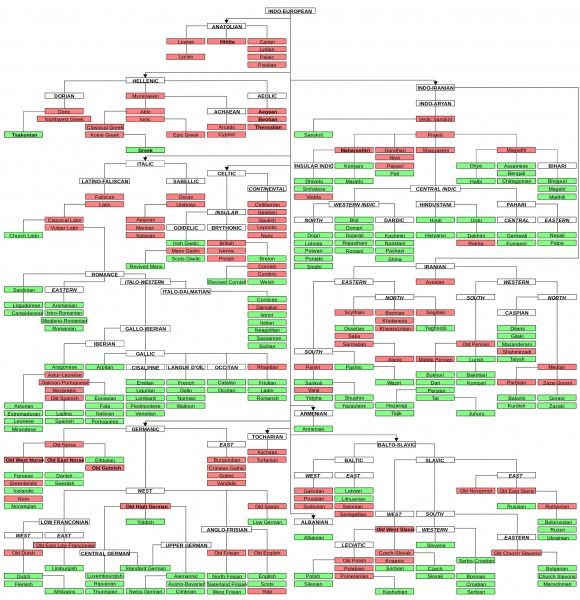
Indo-European language family tree
Greek
Rather than a branch of languages, Greek is a group of dialects: During more than 3000 years of written history, Greek dialects never evolved into mutually incomprehensible languages. Greek was predominant in the southern end of the Balkans, the Peloponnese peninsula, and the Aegean Sea and its vicinity. The earliest surviving written evidence of a Greek language is Mycenaean, the dialect of the Mycenaean civilization, mainly found on clay tablets and ceramic vessels on the isle of Crete. Mycenaean did not have an alphabetic written system, rather it had a syllabic script known as the Linear B script.
The first alphabetic inscriptions have been dated back to the early 8th century BCE, which is probably the time when the Homeric epics, the Iliad and the Odyssey, reached their present form. There were many Greek dialects in ancient times, but because of Athens cultural supremacy in the 5th century BCE, it was the Athens dialect, called Attic, the one that became the standard literary language during the Classical period (480-323 BCE). Therefore, the most famous Greek poetry and prose written in Classical times were written in Attic: Aristophanes, Aristotle, Euripides, and Plato are just a few examples of authors who wrote in Attic.
Italic
This branch was predominant in the Italian peninsula. The Italic people were not natives of Italy ; they entered Italy crossing the Alps around 1000 BCE and gradually moved southward. Latin, the most famous language in this group, was originally a relatively small local language spoken by pastoral tribes living in small agricultural settlements in the centre of the Italian peninsula. The first inscriptions in Latin appeared in the 7th century BCE and by the 6th century BCE it had spread significantly.
Rome was responsible for the growth of Latin in ancient times. Classical Latin is the form of Latin used by the most famous works of Roman authors like Ovid, Cicero, Seneca, Pliny, and Marcus Aurelius. Other languages of this branch are: Faliscan, Sabellic, Umbrian, South Picene, and Oscan, all of them extinct.
Today Romance languages are the only surviving descendants of the Italic branch.
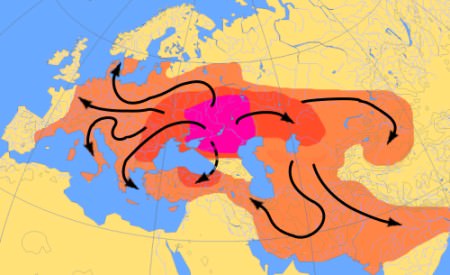
Map of Indo-Euopean Migrations
Celtic
This branch contains two sub-branches: Continental Celtic and Insular Celtic. By about 600 BCE, Celtic-speaking tribes had spread from what today are southern Germany, Austria, and Western Czech Republic in almost all directions, to France, Belgium, Spain, and the British Isles, then by 400 BCE, they also moved southward into northern Italy and southeast into the Balkans and even beyond. During the early 1st century BCE, Celtic-speaking tribes dominated a very significant portion of Europe. On 50 BCE, Julius Caesar conquered Gaul (ancient France) and Britain was also conquered about a century later by the emperor Claudius. As a result, this large Celtic-speaking area was absorbed by Rome, Latin became the dominant language, and the Continental Celtic languages eventually died out. The chief Continental language was Gaulish.
Insular Celtic developed in the British Isles after Celtic-speaking tribes entered around the 6th century BCE. In Ireland, Insular Celtic flourished, aided by the geographical isolation which kept Ireland relatively safe from the Roman and Anglo- Saxoninvasion.
The only Celtic languages still spoken today (Irish Gaelic, Scottish Gaelic, Welsh and Breton) all come from Insular Celtic.
Germanic
The Germanic branch is divided in three sub-branches: East Germanic, currently extinct; North Germanic, containing Old Norse, the ancestor of all modern Scandinavian languages; and West Germanic, containing Old English, Old Saxon, and Old High German.
The earliest evidence of Germanic-speaking people dates back to first half of the 1st millennium BCE, and they lived in an area stretching from southern Scandinavia to the coast of the North Baltic Sea. During prehistoric times, the Germanic speaking tribes came into contact with Finnic speakers in the north and also with Balto-Slavic tribes in the east. As a result of this interaction, the Germanic language borrowed several terms from Finnish and Balto-Slavic.
Several varieties of Old Norse were spoken by most Vikings. Native Nordic pre-Christian Germanic mythology and folklore has been also preserved in Old Norse, in a dialect named Old Icelandic.
Dutch, English, Frisian, and Yiddish are some examples of modern survivors of the West Germanic sub-branch, while Danish, Faroese, Icelandic, Norwegian, and Swedish are survivors of the North Germanic branch.
Armenian
The origins of the Armenian-speaking people is a topic still unresolved. It is probable that the Armenians and the Phrygians belonged to the same migratory wave that entered Anatolia, coming from the Balkans around the late 2nd millennium BCE.The Armenians settled in an area around Lake Van, currently Turkey; this region belonged to the state of Urartu during the early 1st millennium BCE. In the 8th century BCE, Urartu came under Assyrian control and in the 7th century BCE, the Armenians took over the region. The Medes absorbed the region soon after and Armenia became a vassal state. During the time of the Achaemenid Empire, the region turned into a Persian satrap. The Persian domination had a strong linguistic impact on Armenian, which mislead many scholars in the past to believe that Armenian actually belonged to the Iranian group.
Tocharian
The history of the Tocharian-speaking people is still surrounded by mystery. We know that they lived in the Taklamakan Desert, located in western China. Most of the Tocharian texts left are translations from well-known Buddhist works, and all of these texts have been dated between the 6th and the 8th centuries CE. None of these texts speak about the Tocharians themselves.Two different languages belong to this branch: Tocharian A and Tocharian B. Remains of the Tocharian A language have only been found in places where Tocharian B documents have also been found, which would suggest that Tocharian A was already extinct, kept alive only as a religious or poetic language, while Tocharian B was the living language used for administrative purposes.
Many well-preserved mummies with Caucasoid features such as tall stature, red, blonde, and brown hair, have been discovered in the Taklamakan Desert, dating between 1800 BCE to 200 CE. The weaving style and patterns of their clothes is similar to the Hallstatt culture in central Europe. Physical analysis and genetic evidence have revealed resemblances with the inhabitants of western Eurasia.
This branch is completely extinct. Among all ancient Indo-European languages, Tocharian was spoken farthest to the east.
Balto-Slavic
This branch contains two sub-branches: Baltic and Slavic.
During the late Bronze Age, the Balts' territory may have stretched from around western Poland all the way across to the Ural Mountains. Afterwards, the Balts occupied a small region along the Baltic Sea. Those in the northern part of the territory occupied by the Balts were in close contact with Finnic tribes, whose language was not part of the Indo-European language family: Finnic speakers borrowed a considerable amount of Baltic words, which suggests that the Balts had an important cultural prestige in that area. Under the pressure of Gothic and Slavic migrations, the territory of the Balts was reduced towards the 5th century CE.
Archaeological evidence shows that from 1500 BCE, either the Slavs or their ancestors occupied an area stretching from near the western Polish borders towards the Dnieper River in Belarus. During the 6th century CE, the Slav-speaking tribes expanded their territory, migrating into Greece and the Balkans: this is when they are mentioned for the first time, in Byzantine records referring to this large migration. Either some or all of the Slavs were once located further to the east, in or around Iranian territory, since many Iranian words were borrowed into pre-Slavic at an early stage. Later on, as they moved westward, they came into contact with German tribes and again borrowed several additional terms.
Only two Baltic languages survive today: Latvian and Lithuanian. A large number of Slavic languages survive today, such as Bulgarian, Czech, Croatian, Polish, Serbian, Slovak, Russian, and many others.
Albanian
Albanian is the last branch of Indo-European languages to appear in written form. There are two hypotheses on the origin of Albanian. The first one says that Albanian is a modern descendant of Illyrian, a language which was widely spoken in the region during classical times. Since we know very little about Illyrian, this assertion can be neither denied nor confirmed from a linguistic standpoint. From a historical and geographical perspective, however, this assertion makes sense. Another hypotheses says that Albanian is a descendant of Thracian, another lost language that was spoken farther east than Illyrian.
Today Albanian is spoken in Albania as the official language, in several other areas in of the former Yugoslavia and also in small enclaves in southern Italy, Greece and the Republic of Macedonia.
Unaffiliated Languages
All languages in this group are either extinct or they are a former stage of a modern language. Examples of this groups of languages are Phrygian, Thracian, Ancient Macedonian (not to be confused with Macedonian, a language currently spoken in the Republic of Macedonia, part of the Slavic branch), Illyrian, Venetic, Messapic, and Lusitanian.
INDO-EUROPEAN HISTORICAL LINGUISTICS
In ancient times it was noticed that some languages presented striking similarities: Greek and Latin are a well-known example.During classical antiquity it was noted, for example, that Greek héks “six” and heptá “seven” were similar to the Latin sex and septem. Furthermore, the regular correspondence of the initial h- in Greek to the initial s- in Latin was pointed out.
The explanation that the ancients came up with was that the Latin language was a descendant of Greek language. Centuries later, during and after the Renaissance, the close similarities between more languages were also noted, and it was understood that certain groups of languages were related, such as Icelandic and English, and also the Romance languages. Despite all of these observations, the science of linguistics did not develop much further until the 18th century CE.
During the British colonial expansion into India, a British orientalist and jurist named Sir William Jones became familiar with the Sanskrit language. Jones was also knowledgeable in Greek and Latin and was surprised by the similarities between these three languages. During a lecture on February 2, 1786 CE, Sir William Jones expressed his new ideas:
The Sanskrit language, whatever be its antiquity, is of a wonderful structure; more perfect than the Greek, more copious than the Latin, and more exquisitely refined than either, yet bearing to both of them a stronger affinity, both in the roots of verbs and the forms of grammar, than could possibly have been produced by accident; so strong indeed, that no philologer could examine them all three, without believing them to have sprung from some common source, which, perhaps, no longer exists; there is a similar reason, though not quite so forcible, for supposing that both the Gothic and the Celtic, though blended with a very different idiom, had the same origin with the Sanskrit; and the old Persian might be added to the same family, if this were the place for discussing any question concerning the antiquity of Persia. (Fortson, p. 9)
The idea that Greek, Latin, Sanskrit, and Persian were derived from a common source was revolutionary at that time. This was a turning point in the history of linguistics. Rather than the “daughter” of Greek, Latin was for the first time understood as the “sister” of Greek. By becoming familiar with Sanskrit, a language geographically far removed from Greek and Latin, and realizing that chance was an insufficient explanation for the similarities between these languages, Sir William Jones presented a new insight which triggered the development of modern linguistics.
LICENSE:
Article based on information obtained from these sources:with permission from the Website Ancient History Encyclopedia
Content is available under License Creative Commons: Attribution-NonCommercial-ShareAlike 3.0 Unported. CC-BY-NC-SA License